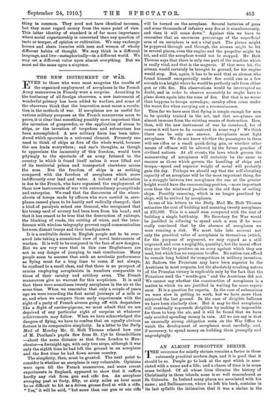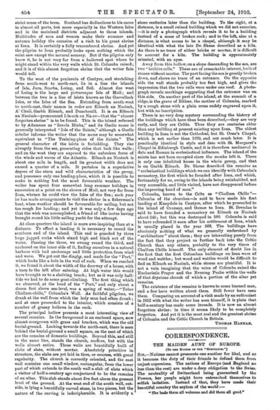AN ALMOST FORGOTTEN SHRINE.
THE reverence for saintly shrines remains a. factor in these extremely practical modern days, and it is good that it should be so. People go to look at the spot which is asso- ciated with a name and a life; and a chasm of time is in some sense bridged. Of all whose lives illumine the history of Christianity in these islands, none is so well remembered as St. Columba. In Ireland many places are associated with his name ; and Ballinascreen, where he left his book, contains in its last syllable the intimation that it was a shrine in the strict sense of the term. Scotland has dedications to his name in almost all parts, but more especially in the Western Isles and in the mainland districts adjacent to those islands. Multitudes of men and women make their summer and autumn holiday the occasion of a visit to his great shrine at Iona. It is certainly a fully remembered shrine. And yet the pilgrim to Iona probably looks upon nothing which the saint saw except the natural scenery. But if the pilgrim only knew it, he is not very far from a hallowed spot where he might stand within the very walls which St. Columba raised ; and it is of this almost forgotten shrine that the writer fain would tell.
To the west of the peninsula of Cantyre, and stretching from south-west to north-east, lie in a line the islands of Isla, Jura, Searba, Lasing, and Seil. Almost due west of Luing is the large and picturesque Isle of Mull ; and between the two is a line of islets known as the Garvellech Isles, or the Isles of the Sea. Extending from south-west to north-east, their names in order are Eileach an Naoimh, A' Chuli, Garbh Eileach, and Dunchonill. It is on Eileach an Naoimh—pronounced Ile-ach an Na-ov—that the " almost forgotten shrine " is to be found. This is the island referred to by Adamnan as " Insula Hinba," and its Gaelic name is generally interpreted "Isle of the Saints," although a Gaelic scholar informs the writer that the name may be somewhat equivalent to " The Training-place of the Saints." The general character of the islets is forbidding. They rise abruptly from the sea, presenting sides that look like walls ; and on the west they are exposed to the unbroken force of the winds and waves of the Atlantic. Eileach an Naoimh is about one mile in length, and its greatest width does not exceed a quarter of a mile. It partakes in a superlative degree of the stern and wild characteristics of the group, and possesses only one landing-place, which it is possible to make in nothing but the most favourable weather. The writer has spent four somewhat long summer holidays in succession at a point on the shores of Mull, not very far from Iona, whence he could view the Isles of the Sea ; each year he has made arrangements to visit the shrine in a fisherman's boat, when weather should be favourable for sailing, but not too rough for landing; and yet it was only a few days ago that the wish was aceomplished, a friend of like tastes having brought round his little paling yacht for the attempt.
At close quarters the island is more awe-inspiring than at a distance. To effect a landing it is necessary to round the southern end of the island. This end is guarded by three huge jagged rocks which stand high and black out of the water. Passing the three, we swung round the third, and anchored on the inner side of it, finding ourselves in a natural harbour with bad anchorage and little protection from wind and wave. We got out the dinghy, and made for the "Port," which looks like a. hole in the wall of rock. When we reached it, we found it about the width of the doorway of a house, with a turn to the left after entering. At high water this would have brought us to a shelving beach; but as it was only half- tide we had to do some goat-climbing. The first thing which we observed, at the head of the "Port," and only about a dozen feet above sea-level, was a spring of water,—" Tober Challum-chille," Columba's Well. As faithful pilgrims, we drank at the well from which the holy man had often drunk ; and at once proceeded to the interior, which consists of a number of grassy hollows in the rock.
The principal hollow presents a most interesting view of several remains. In the foreground is an enclosed space, now almost overgrown with grass and bracken, which was the old burial-ground. Looking towards the north-east, there is seen behind the burial-ground a small square, on the east of which are the remains of domestic buildings. Beyond this, and still in the same line, stands the church, roofless, but with the walls almost entire. These walls are beautifully built of slabs of slate, without mortar. Absolutely primitive in stricture, the slabs axe yet laid in tiers, or courses, with great regularity. The church is correctly oriented, and the east wall contains one small window, rectangular, from the lower part of which extends to the south wall a slab of slate which a visitor of half-a-century ago conjectured to be the remains of an altar. This slab stands about five feet above the present level of the ground. At the west end of the south wall, out- side, is lying a beautifully carved stone, in two pieces, but the nature of the carving is indecipherable. It is evidently a stone centuries later than the building. To the right, at a distance, is a small ruined building which we did not examine, —it is only a photograph which reveals it to be a building instead of a mass of broken rock; and to the left, also at a distance, is what seems to be a chapel, although it may be identical with what the late Dr. Skene described as a kiln. As there is no trace of either bricks or mortar, it is difficult to account for a kiln. The building is approximately oriented, with an apse.
Away from this hollow, on a slope descending to the sea, are two " beehive cells." These are of remarkable interest, built of stones without mortar. The part facing the sea is greatly broken down, and shows no trace of an entrance. On the opposite side the wall stands probably ten feet high, and gives the impression that the two cells were under one roof. A photo- graph reveals markings suggesting that the entrance was on this side. On another part of the island, at the summit of a ridge, is the grave of Eithne, the mother of Columba, marked by a rough stone with a plain cross rudely engraved upon it, but with no inscription.
There is no very deep mystery surrounding the history of the buildings which have thus been described,—they are very early, and they are Celtic. Thus they are centuries older than any building at present existing upon Iona. The oldest building in Iona is not the Cathedral, but St. Oran's Chapel, which is not earlier than 1070, and not much later. It is practically identical in style and date with St. Margaret's Chapel in Edinburgh Castle, and it is therefore mediaeval in date and Roman in ecclesiastical influence. The island of the saints has not been occupied since the monks left it. There is only one inhabited house in the whole group, and that is on Garbh Eileach. Dr. Skene described the remains as "ecclesiastical buildings which we can identify with Columba's monastery, the first which he founded after Iona, and which, fortunately for us, owing to the islands being uninhabited, not very accessible, and little visited, have not disappeared before the improving hand of man."
Columba, known to the Celts as " Challum Chile"— Columba of the churches—is said to have made his first landing at Knapdale in Cantyre, after which he proceeded to the island of Oronsay, and thence to Iona. St. Brendan is said to have founded a monastery on Eileach as Naoimh about 545; but this was destroyed in 560. Columba is said to have refounded it soon after his settlement of Iona, which is usually placed in the year 563. The buildings have absolutely nothing of what we generally understand by " architecture" about them; they are interesting purely from the fact that they project us further back into the Celtic Church than any others, probably to the very times of Challum Chile himself. The only element of doubt lies in the fact that the first Columban buildings on Iona were of wood and wattles ; but wood and wattles would be difficult to find on Eileach an Naoimh, while stones are plentiful. It is not a vain imagining that the voice of Columba raised the Eucharistic Prayer and the Evening Psalm within the walls of that drystone chard' of which a portion of the altar yet remains.
The existence of the remains is known to some learned men, and a few have written about them. Still fewer have seen them. Comparing an account of a visit made by an enthusiast in 1852 with what the writer has seen himself, it is plain that half-a-century has made some inroads. It is now an almost forgotten shrine : in time it seems likely to be completely forgotten. And yet it is the most real and the greatest shrine of Columba and the Celtic Church in Britain.
THOMAS HANNAN.











































 Previous page
Previous page